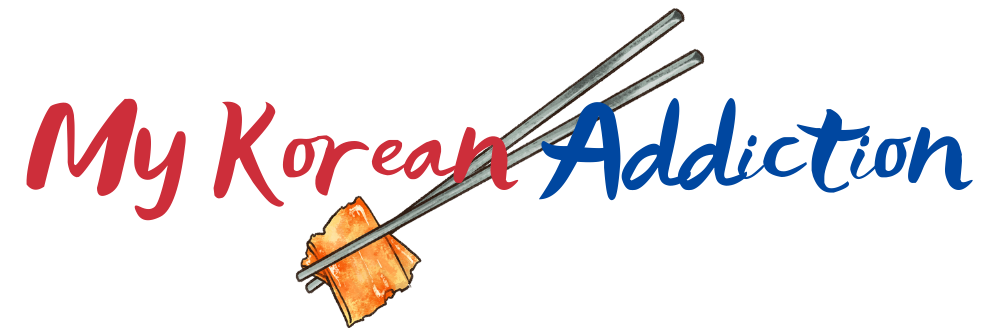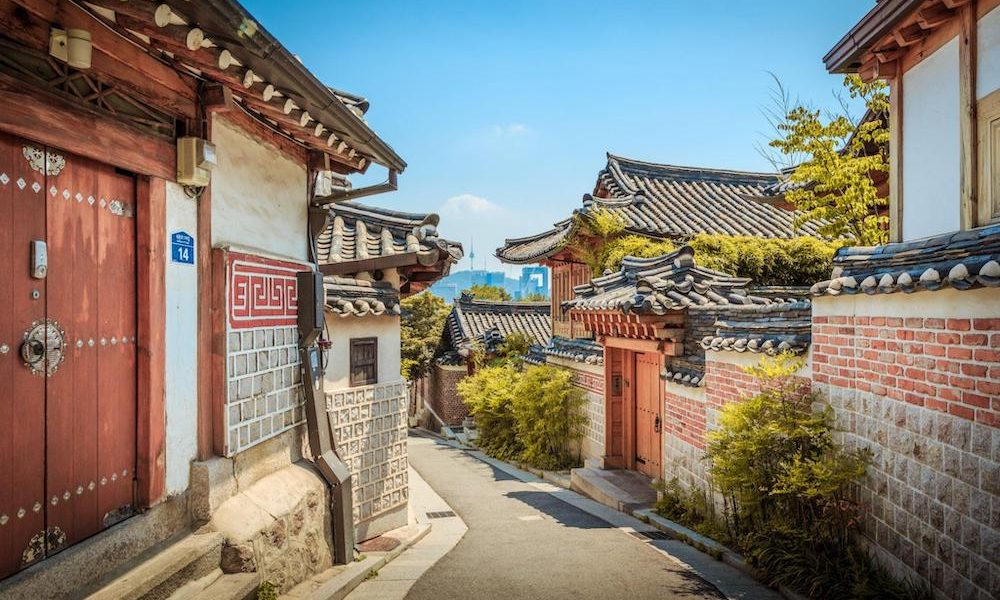Planning your first-ever trip to Seoul? Looking at returning to this wonderfully addictive city of culinary delights and cultural experiences?
Like many others worldwide, you’re on the right path by landing on this page. Seoul is among the world’s most culturally-rich, exciting, and intoxicating cities.
It’s a perfectly balanced amalgamation of respect for the traditional way of life mixed with modern societal elements that simply take your breath away.
Generational restaurants are a stone’s throw away from international fast-food chains. Hanboks can be seen meshing with street fashion from all over the world on the streets of Hongdae. Centuries-old temples are situated in a city with a population of upwards of 9.9 million people.
A perfect example of this would be Bukchon Hanok Village, located smack-bang in the middle of the city of Seoul. It’s flanked by three of the most long-standing palaces in Korea: Gyeongbukgong, Changdeok, and Jongmyo Royal Palace. All have rich and illustrious histories from centuries ago during the Joseon Era.
However, don’t expect to have to travel far and wide into the mountains to experience these monuments. They’re literally within walking distance of the busiest parts of Seoul!
What’s Bukchon Hanok Village?
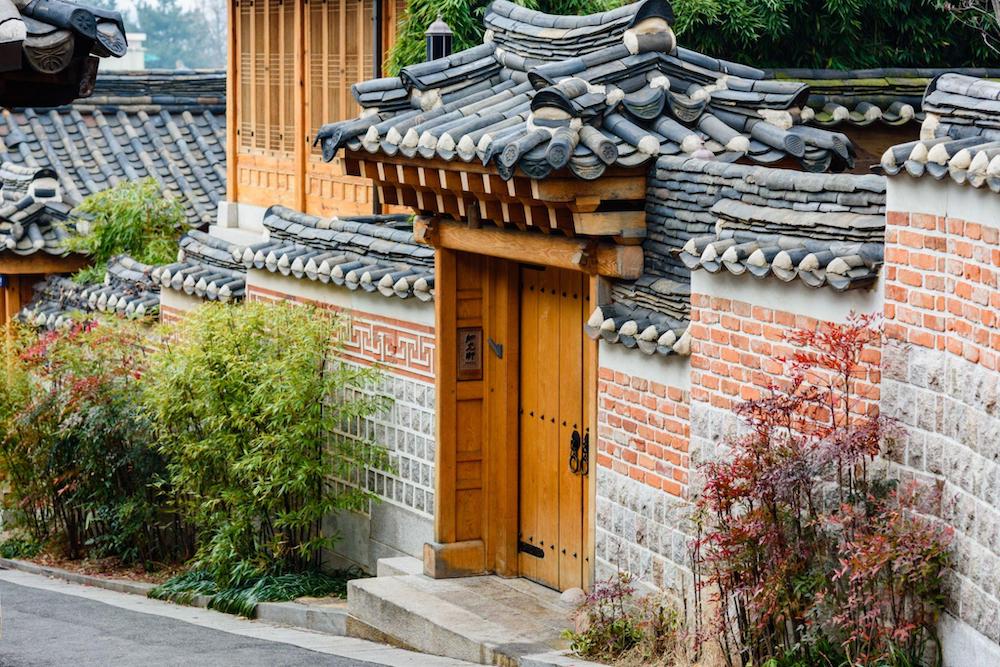
Bukchon Hanok Village is arguably the most popular hanok village in Seoul – even in South Korea. It’s a traditional village that’s filled with hanok-style homes or traditional Korean houses. During the Joseon Era, only those within the high-ranking tier of society resided in Bukchon Hanok Village. From nobility to bureaucrats as well as military officers, you rubbed shoulders with only the ‘elite’ class here.
Fast-forward to today, and Bukchon Hanok Village has gone through a lot. It was almost demolished to make way for urbanization, however, the community banded together and held a convincing enough argument for it to be kept to its original structure.
These days, you will find that many common families live within the hanoks at Bukchon Hanok Village. You’ll also find a sprinkle of traditional restaurants serving cuisine fit for a King, lots of cafes tucked away in the alleyways, small shops selling trinkets, and photo opportunities at every turn.
The 12 Best Things To Do In Bukchon Hanok Village
Without further ado, let us explore some of the best ways you can experience Bukchon Hanok Village.
- Dress up in a hanbok and wander the alleyways
- Eat baked goods at Layered
- Laze away at Onion Cafe
- Explore Gahoe Museum
- Learn something new at the Bukchon Traditional Culture Center
- Take pretty photos of the traditional hanok roofs at Greenmile Coffee
- Enjoy a tea-learning experience at the Traditional Korean Tea Institute
- Explore Songwon Art Center
- Take photos at Gyeongbokgung Palace
- Visit Baek Inje’s house
- Relax at the Cha-teul Traditional Teahouse
- Squeeze in a visit to Ikseondong Hanok Village
In order to make it easy to organise your trip to Bukchon hanok village, we also added these spots to visit in the following map.
1. Dress up in a hanbok and wander the alleyways
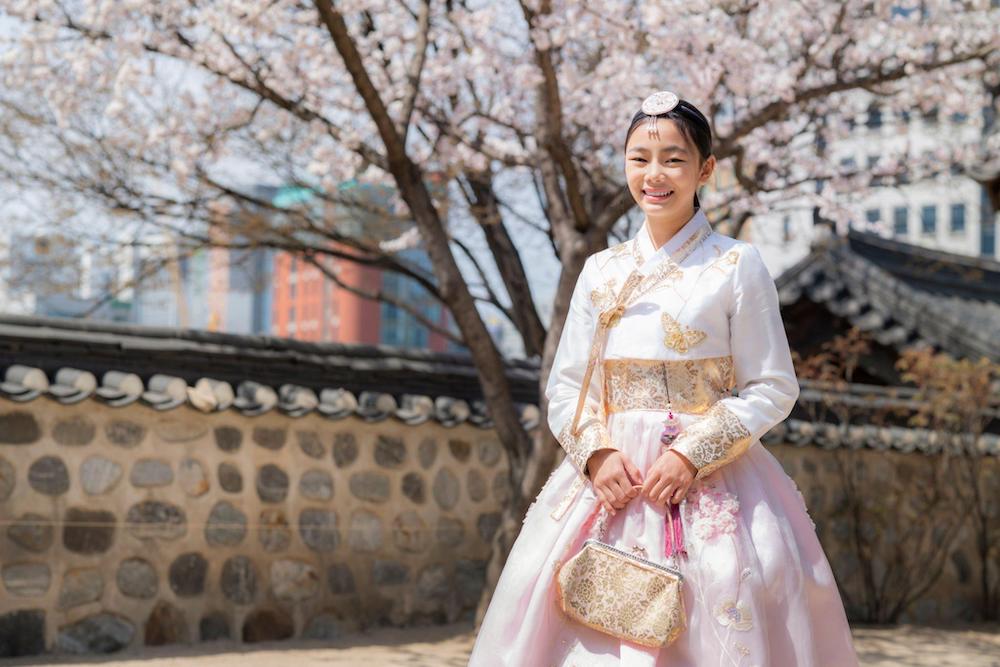
One of the key experiences of visiting South Korea is getting dressed up in a beautiful hanbok costume to take photos. You can do this at many attractions, however, the best place to do this is arguably at Bukchon Hanok Village.
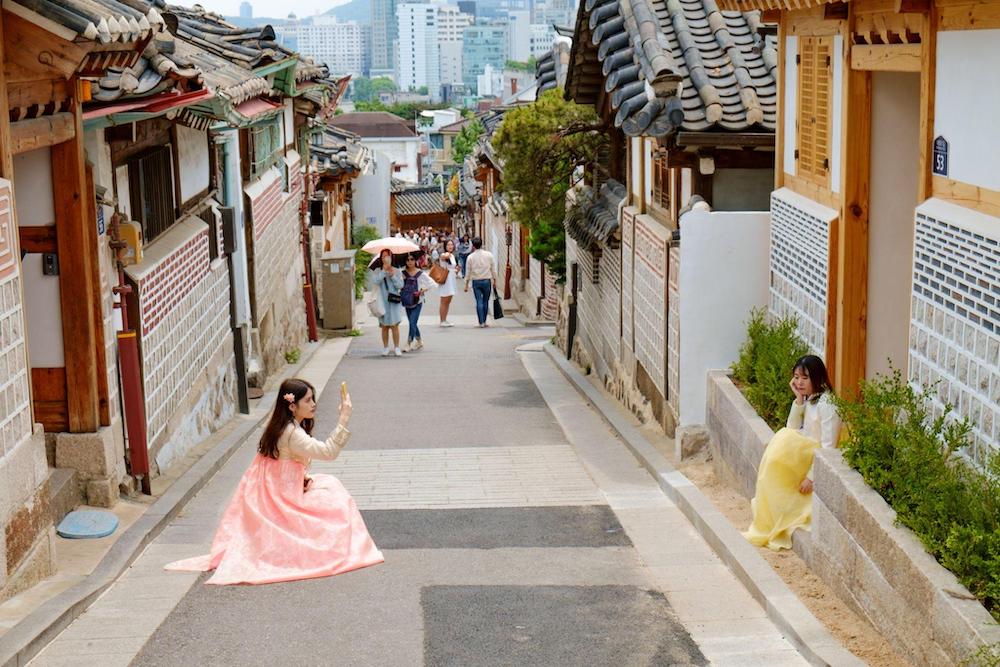
Against the backdrop of the hanok buildings and small alleyways, being dressed up in a hanbok will make you look and feel like royalty back in the Joseon Era. Additionally, the village is situated on top of a hill, so when sunset breaks, you will witness some of the most perfect lighting situations for your photos.
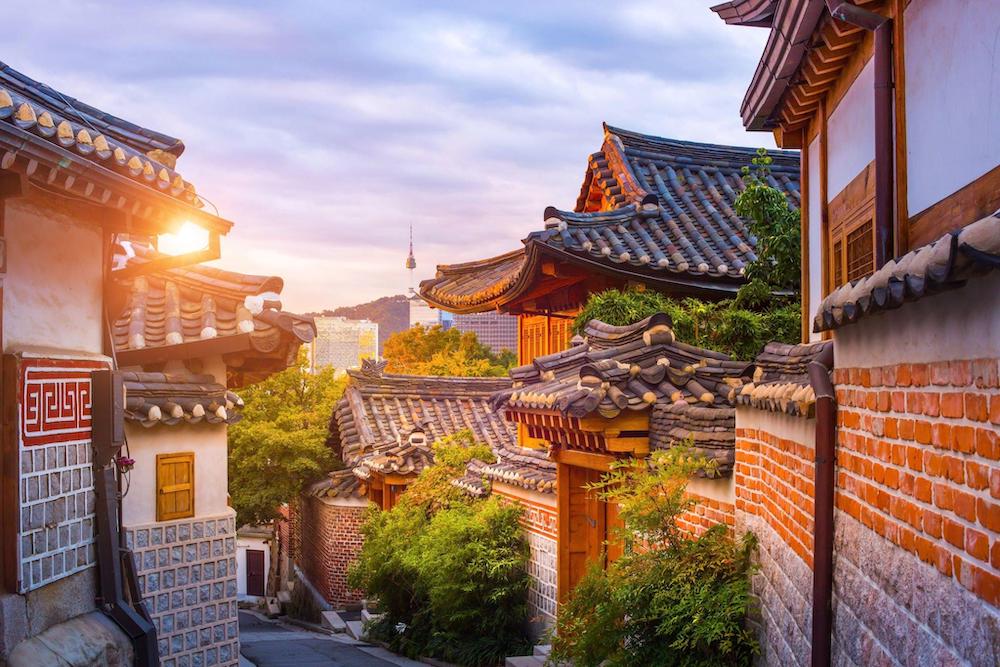
If you’re a little bit embarrassed about getting dressed up, don’t be! On any given day, you’ll see crowds of people, both men and women, dressed up in hanboks in and around Bukchon Hanok Village. It may be weirder to not be in a hanbok! Just kidding, but honestly, it’s one of the best ways to experience this village.
If you are tired of selfies and want to elevate the quality of your pictures, you can hire a local photographer! It’s the new trends right now and they are companies like Photo Trips that can allow you to find great photographers and book them seamlessly.
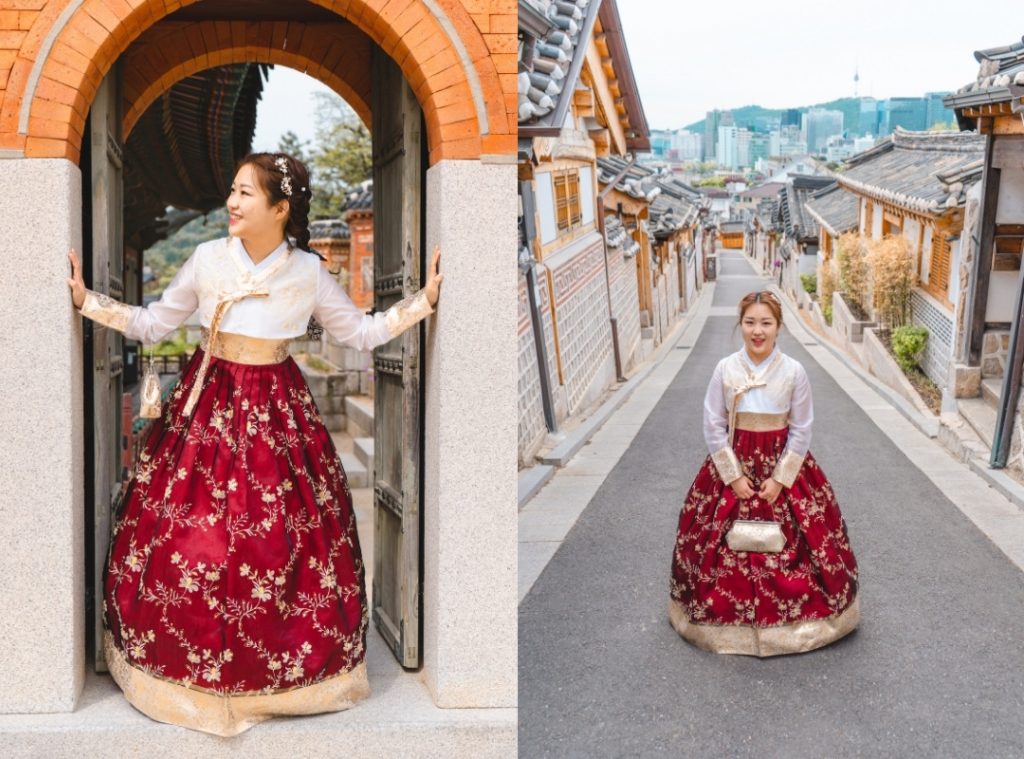
They actually have a specific hanbok photoshoot in Bukchon Hanok village so make sure to check it out! The photographer knows all the best photo spots and will guide on how to pose so you can get the best pictures.
2. Eat baked goods at Layered
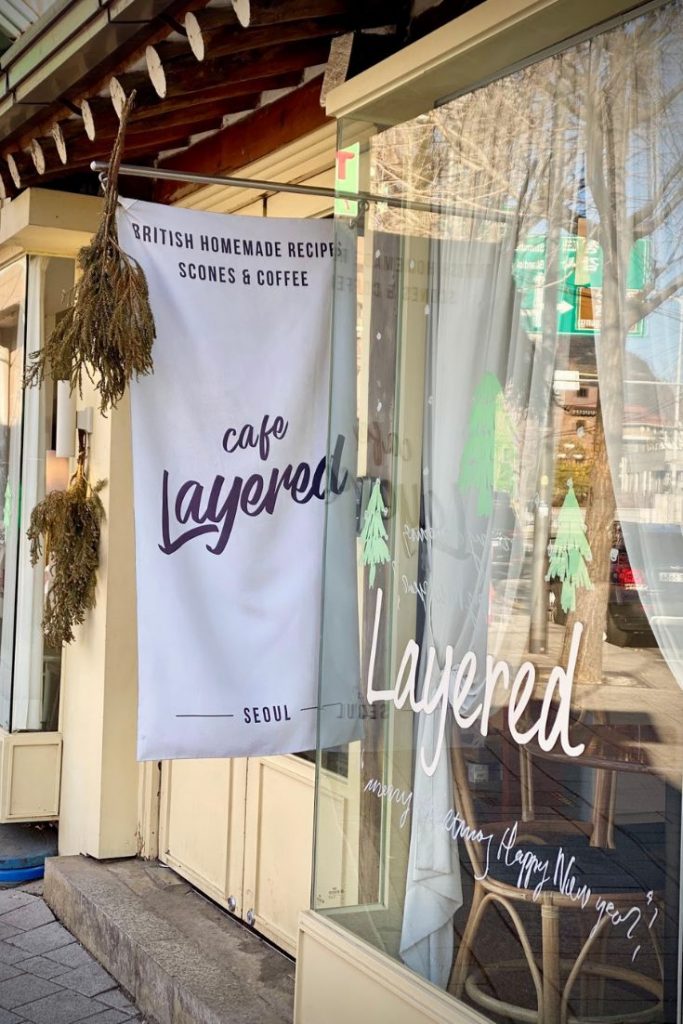
Layered is one of the most popular bakeries situated within Bukchon Hanok Village. On most days, there will be crowds of people milling in and out of the bakery, taking photos in front of its mellow yellow frontage and of its scrumptious pastry displays inside.
It is located within an old converted Hanok house with a clear sky roof, a spacious courtyard, and a convenient location.
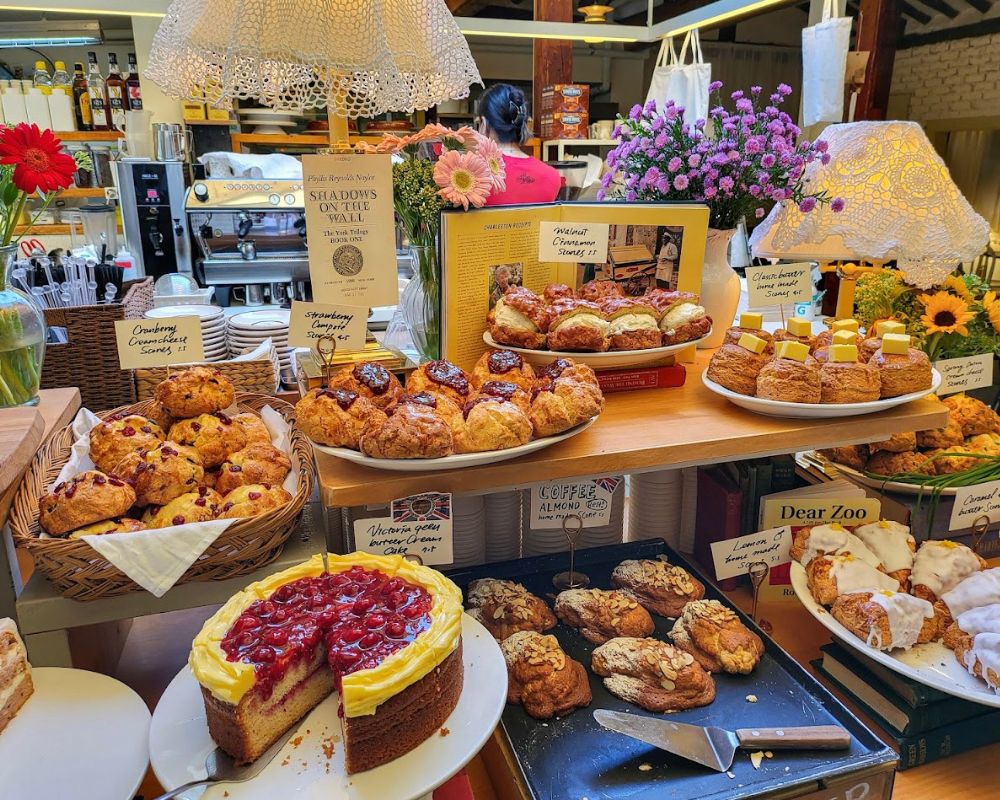
If you’re into aesthetic cakes, fluffy scones, and great coffee, stop by here to have breakfast or a break.
- Address: 2-3 Bukchon-ro 2-gil, Jongno-gu, Seoul, South Korea
- Hours: Mon-Fri: 8:00am-10:00pm, Sat-Sun: 10:00am-10:00pm
3. Laze away at Onion Cafe
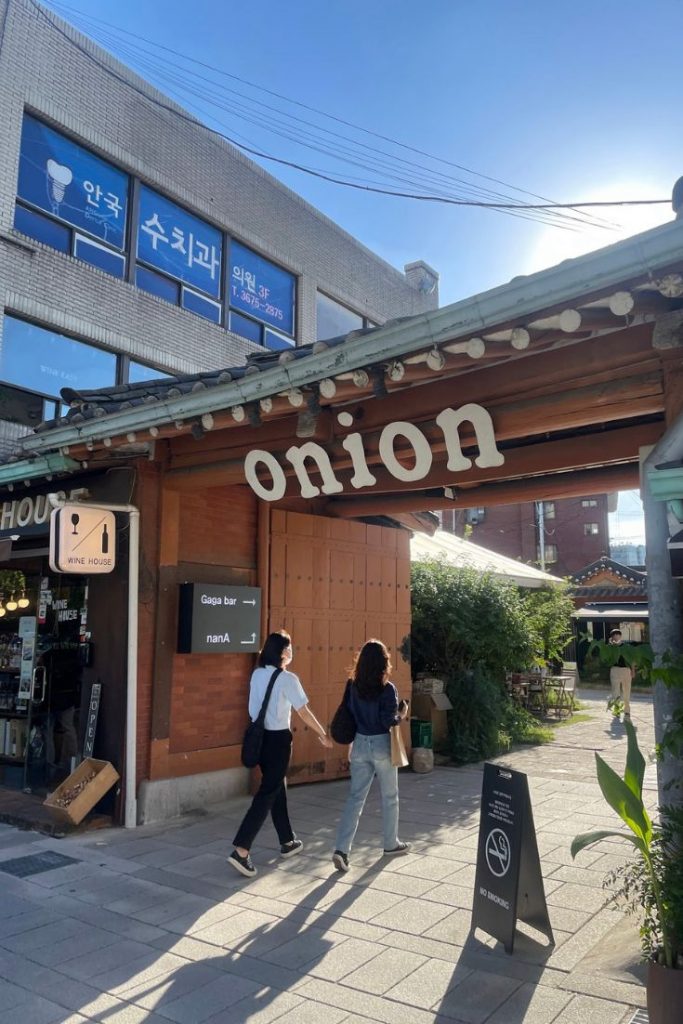
Onion Cafe first opened up in Seongsu-dong, the hipster area of Seoul. After its success, it opened up a location in Bukchon and it’s been going gangbusters since then.
This super aesthetic cafe is located within a hanok building that’s retained much of its framework structure. Much like the design of many hanok homes, all areas of the cafe look toward the center, which is an open space. You can choose to sit inside and look out through huge glass windows or relax outside on one of the surrounding steps of the courtyard.
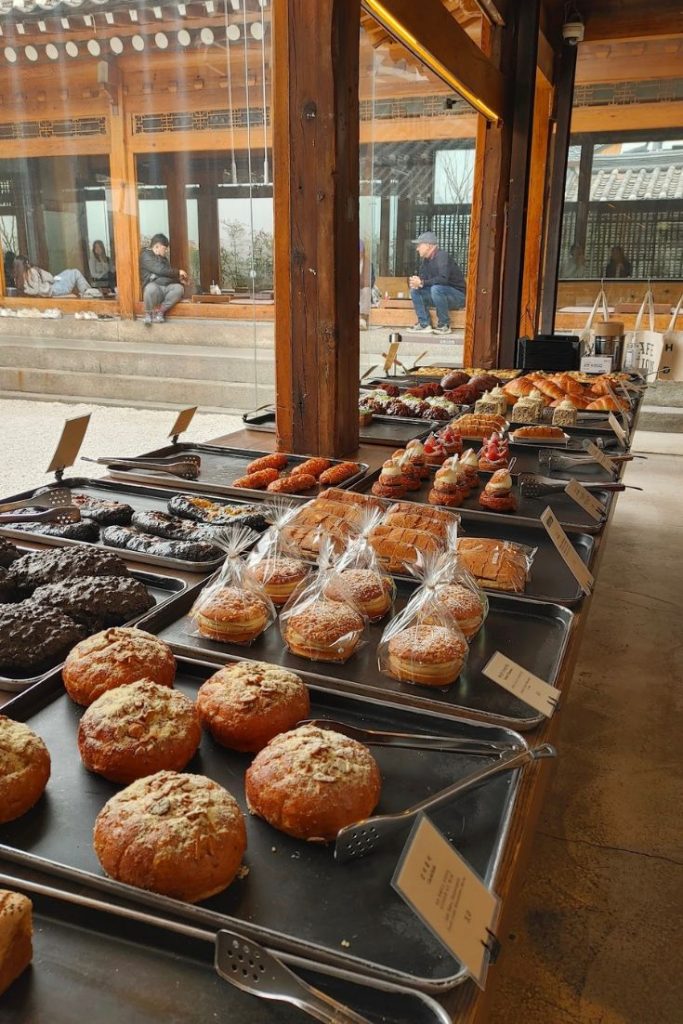
Onion Cafe is known for its amazing bread and pastries, most notably their Pandoro, an Italian-style bread topped with powdered sugar.
This cafe is distinctly slow-paced despite the huge number of visitors here daily. If you’re not in a rush, find yourself a spot and soak in the ambiance.
- Address: South Korea, Seoul, Jongno-gu
- Hours: Mon-Fri: 9:00am-10:00pm, Sat-Sun: 7:00am-10:00pm
You can discover more unique cafe in this article about the best Hanok cafes in Seoul.
4. Explore Gahoe Museum
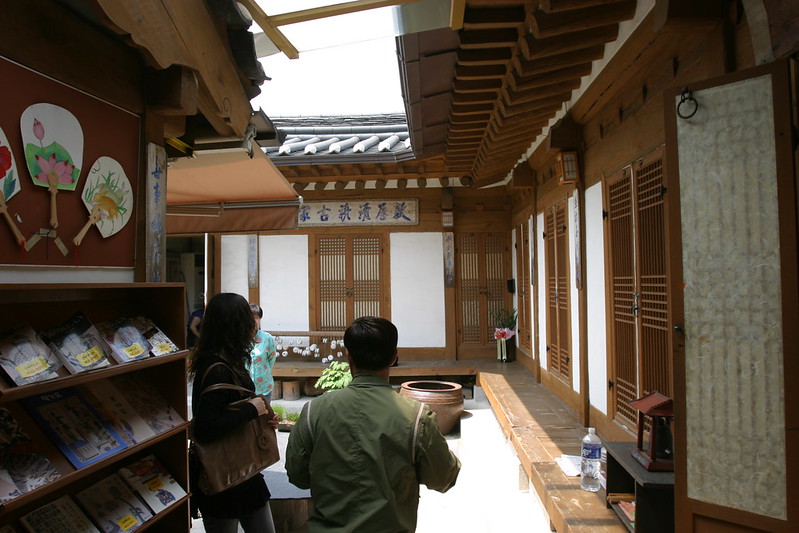
Gahoe Museum is not quite your typical museum. Located within a hanok building, this museum introduces the world of Korean folk traditions to the public. Featuring thousands of old relics including amulets, books, paintings, and much more, the collection here is quite impressive.
You will learn about preserved folk art that’s been around for hundreds of years. You’ll learn why and how colors and symbolism were used in folk tradition back in history.
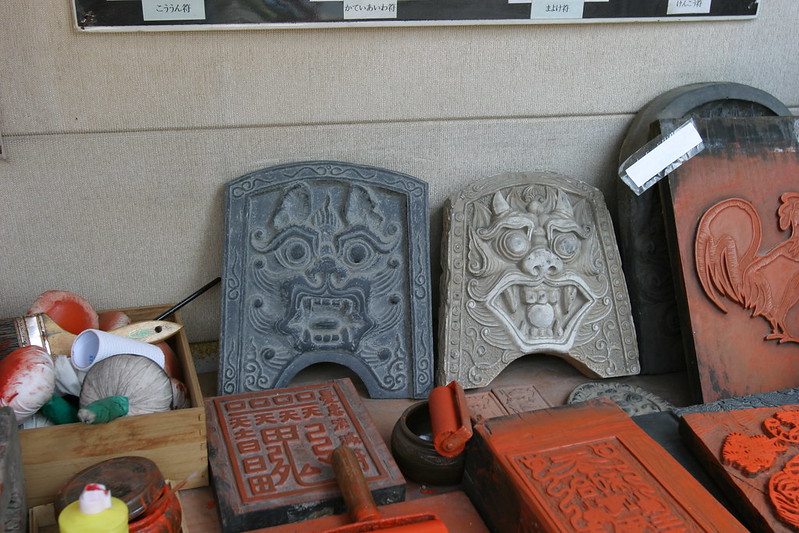
One of the best things about this museum is that it’s a rather hands-on museum that allows people of all ages to engage in their activities. For example, one of their most popular workshops includes the Gahoe Folk Painting Workshop, where visitors are taught how to paint in the style of folk art.
It’s a wonderful attraction for friends and family alike.
- Address: 52 Bukchon-ro, Gahoe-dong, Jongno-gu, Seoul, South Korea
- Hours: 10:00am-6:00pm (Closed Mondays)
- Price: 5000 won
5. Learn something new at the Bukchon Traditional Culture Center
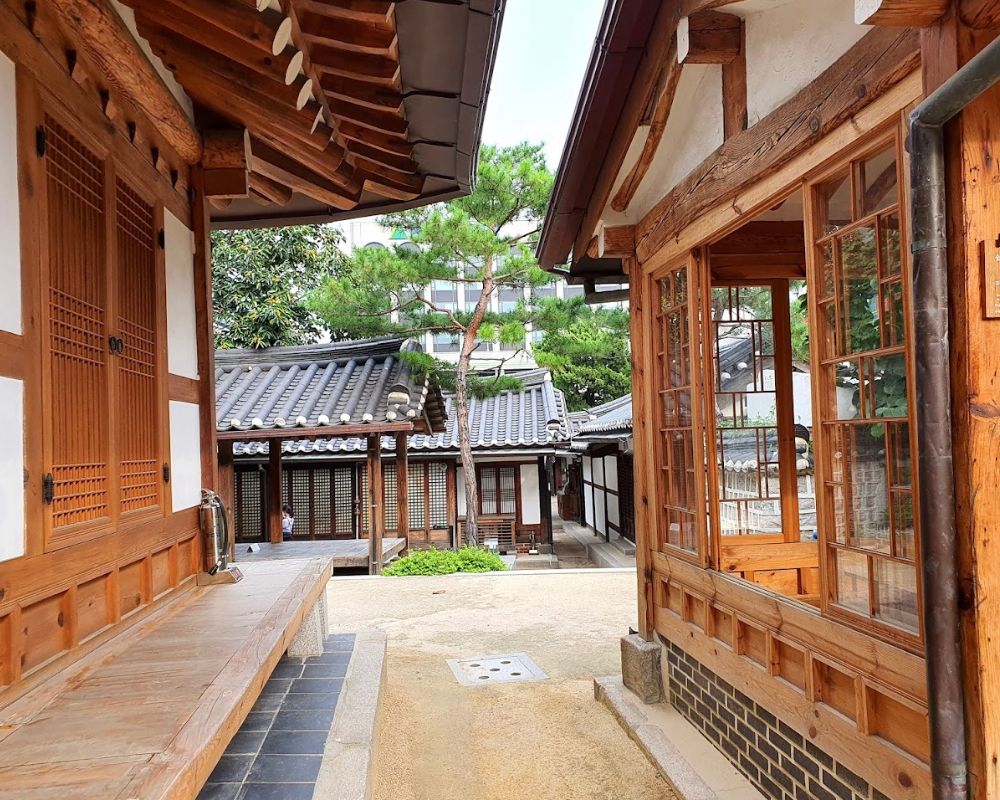
The Bukchon Traditional Culture Center is where you’d want to start your Bukchon visit if you’re keen to learn about the history of the hanok village. This is a self-guided tour, so you can either take your time reading up all the information or breeze through and learn bits and pieces as you go.
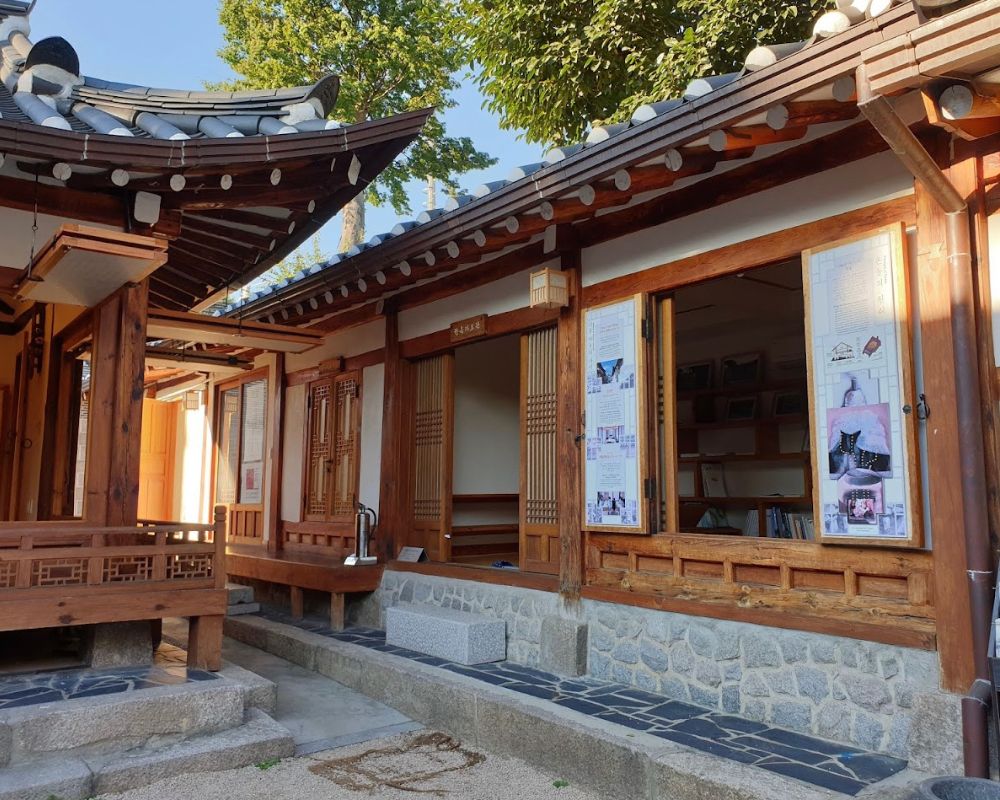
Here, you can learn about the structure of hanoks and why they are built the way they are. Much like the intricacies of a hanbok costume, a hanok boasts symbolism and intricate detailing in every part of its formation. It’s surprisingly riveting to read about, and we highly recommend a visit here to laden yourself with this information.
Once you’re done, grab a map of the Bukchon Hanok Village, and off exploring you go!
- Address: South Korea, Seoul, Jongno-gu
- Hours: Mon-Fri: 9:00am-6:00pm, Sat-Sun: 9:00am-5:00pm
6. Take pretty photos of the traditional hanok roofs at Greenmile Coffee
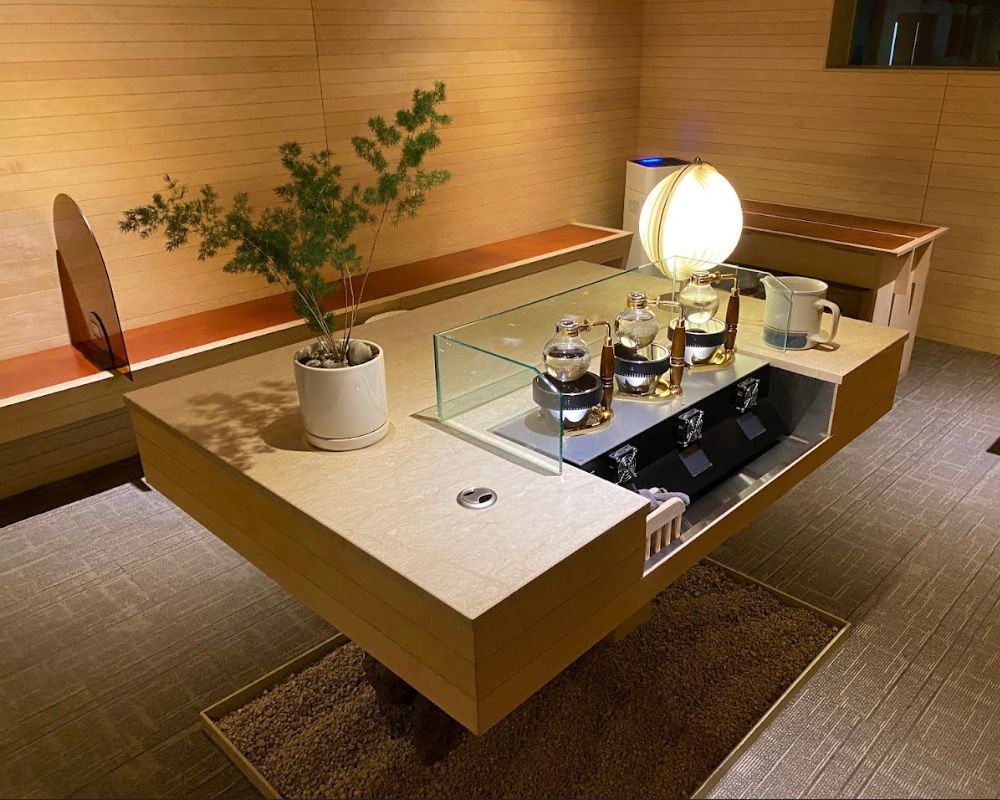
Greenmile Coffee lives up to its name: it boasts a mean signature drink called the Greenmile Coffee that’s the perfect balance of green tea in a latte form. Many customers have praised this drink for having a strong enough green tea flavor without compromising on the smoothness of the latte.
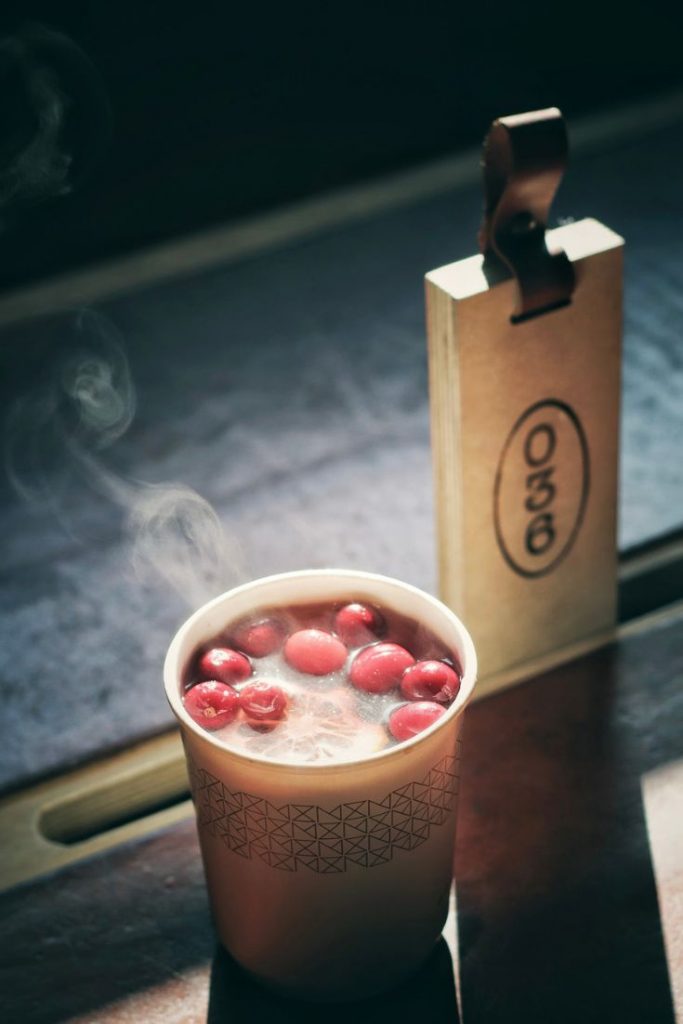
Greenreenmile Coffee is also known for its great coffee and aesthetic cafe vibes. They serve espressos, siphon, and filter coffee. The café can be described as having a clean, light-filled wooden interior comprising minimalist furniture and a relaxing ambiance.
However, one of the best things about this cafe is the fact that its rooftop offers one of the most unique and highly sought-after views of Bukchon Hanok Village.
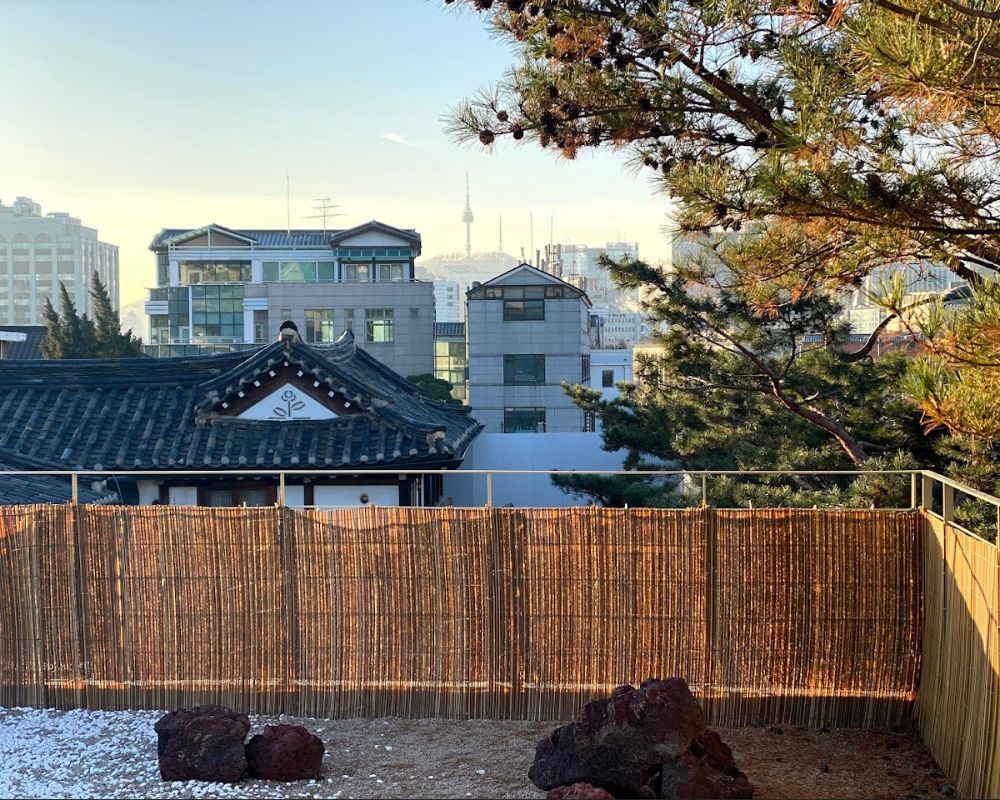
If you’re looking to get a photo that’s representative of Bukchon but isn’t one of its smaller alleyways flanked by hanok homes, head to the rooftop of Greenmile Coffee.
There, you’ll witness many hanok roofs, one after another, backed by a clear blue sky (on a good day!). Honestly, it makes for a super picturesque location that’s scored plenty of visits from tourists.
- Address: 64 Bukchon-ro, Gahoe-dong, Jongno-gu, Seoul, South Korea
- Hours: Mon-Fri: 9:00am-7:00pm, Sat-Sun: 10:00am-7:00pm
7. Enjoy a tea-learning experience at the Traditional Korean Tea Institute
If you’re a tea fanatic, pop by the Traditional Korean Tea Institute to learn more about the centuries-long history of a traditional Korean tea ceremony.
Here, you will be led through a beautiful tea ceremony where you’ll not only learn about the intricacies of Korean heritage but also bits and pieces about general Korean culture that might just surprise and delight you.
The experience will include a hands-on section where visitors can also take part in the tea-making as well as a food preparation course. Finish off with a green tea hand and foot massage and you’ll be ready to tackle the next part of your itinerary!
- Address of Meeting Point: 50 Yulgok-ro 1-gil Jongno-gu, Seoul, Korea
- Book The Experience Here
- Experience Days: Wednesday & Saturday
8. Explore Songwon Art Center
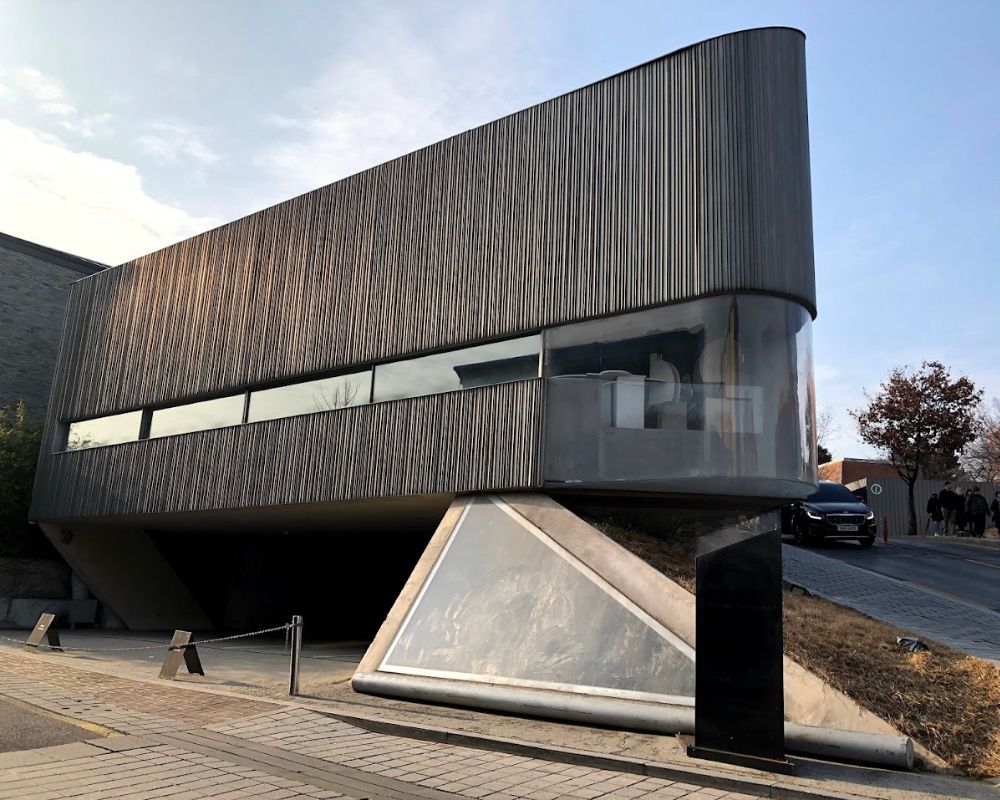
For a bit of a break from traditional sightseeing in Bukchon Hanok Village, we recommend checking out the Songwon Art Center. This art center was founded back in 2006 by Kisu Park.
This art center is exciting because it’s not only the displays within the building that are considered art but the exterior and structure of the buildings as well.
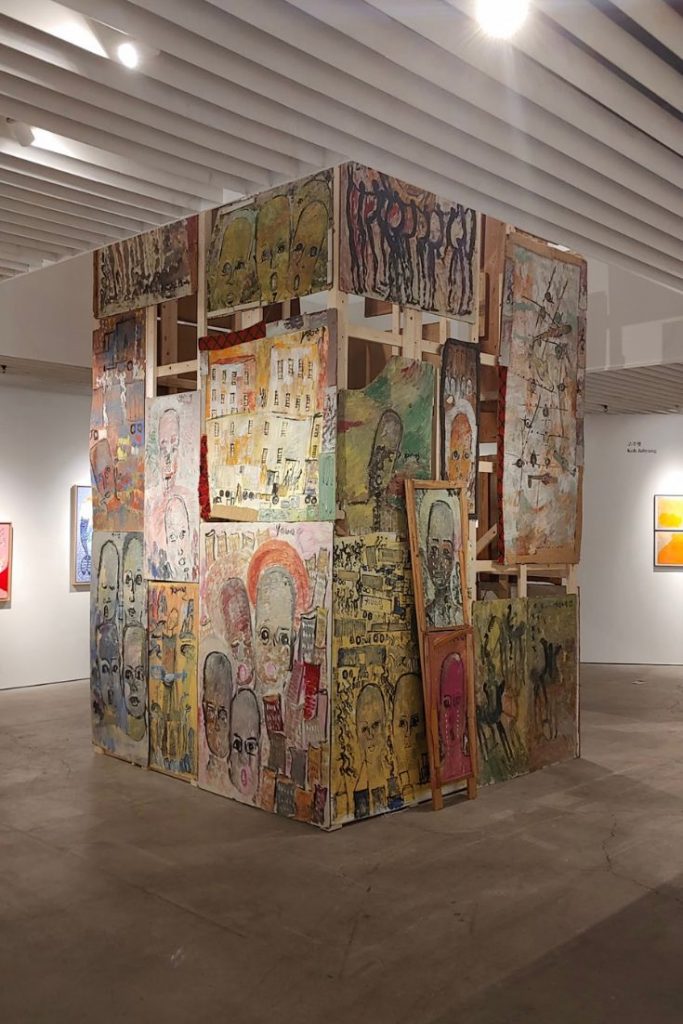
Modern and traditional art and culture come together in a dizzying tiff of exhibitions of young and upcoming artists as well as outlandish and whacky installations that make for great photo opportunities.
- Address: 75 Yunposun-gil, Hwa-dong, Jongno-gu, Seoul, South Korea
- Hours: 11:00am-6:00pm
9. Take photos at Gyeongbokgung Palace
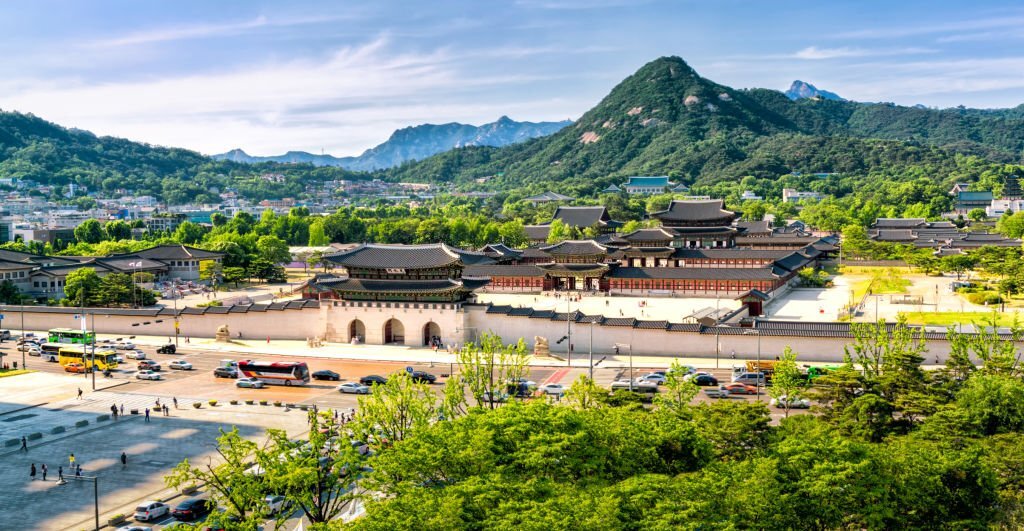
Gyeongbokgung Palace may seem unappealing because of the number of tourists that it pulls daily, however, its magnificence cannot be overlooked.
This grand structure was the main royal palace and served as the home of the family during the illustrious Joseon Era. Fast-forward to today, and it’s been destroyed by war yet rebuilt again to its original impressive structure.
Gyeongbokgung Palace stretches quite wide, so you may or may not fit in all the great sights of these palace grounds in one day. However, you can try it!
Some of the main activities and areas to visit when you’re exploring Gyeongbokgung Palace include the following.
Changing of the Guard
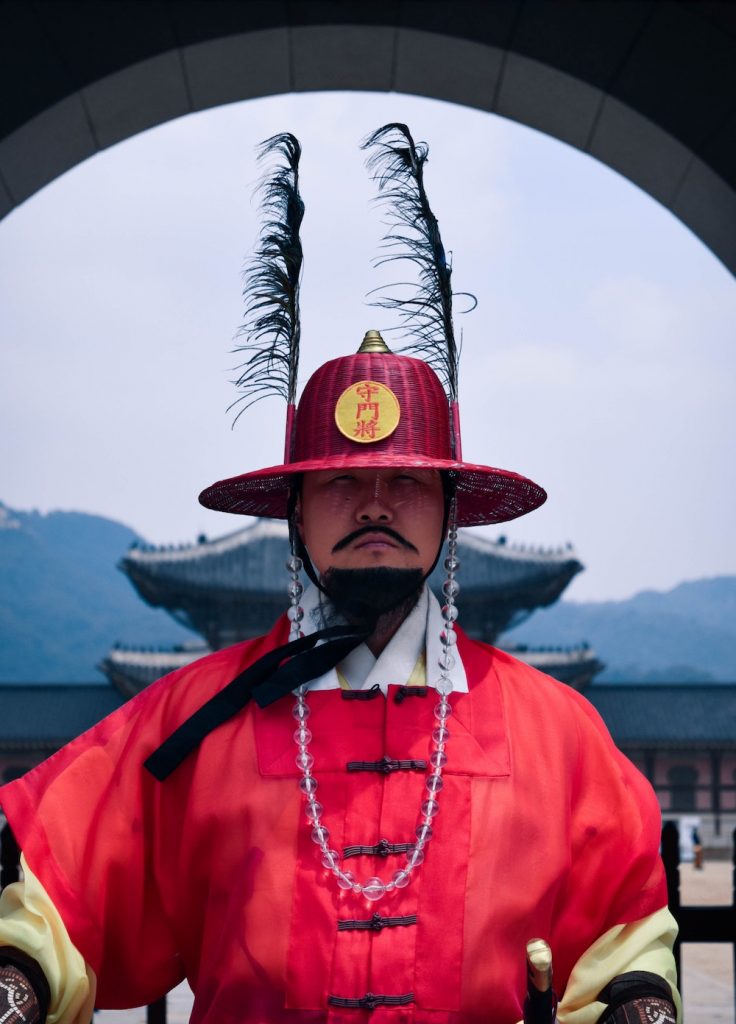
This highly anticipated event has been happening daily since the 14th century during the Joseon Era. There’s nothing quite like hearing the gongs, cymbals, and horn noises rumble through the air as the guards change.
- Time: 10:00am and 2:00pm daily
- Tip: get there with plenty of time to spare so that you get a great spot to witness it.
Take a picture of the Gwanghwamun Gate
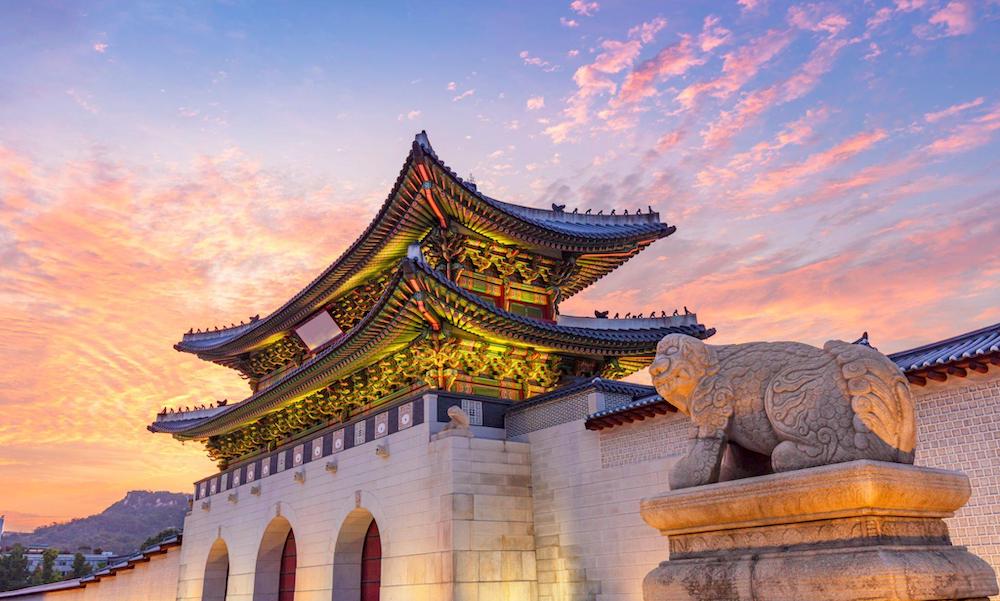
The Gwanghwamun Gate is the main entrance of the royal palace. It’s impressively built, with three arched gate entrances flanked by royal guards.
Explore Geunjeongjeon Hall
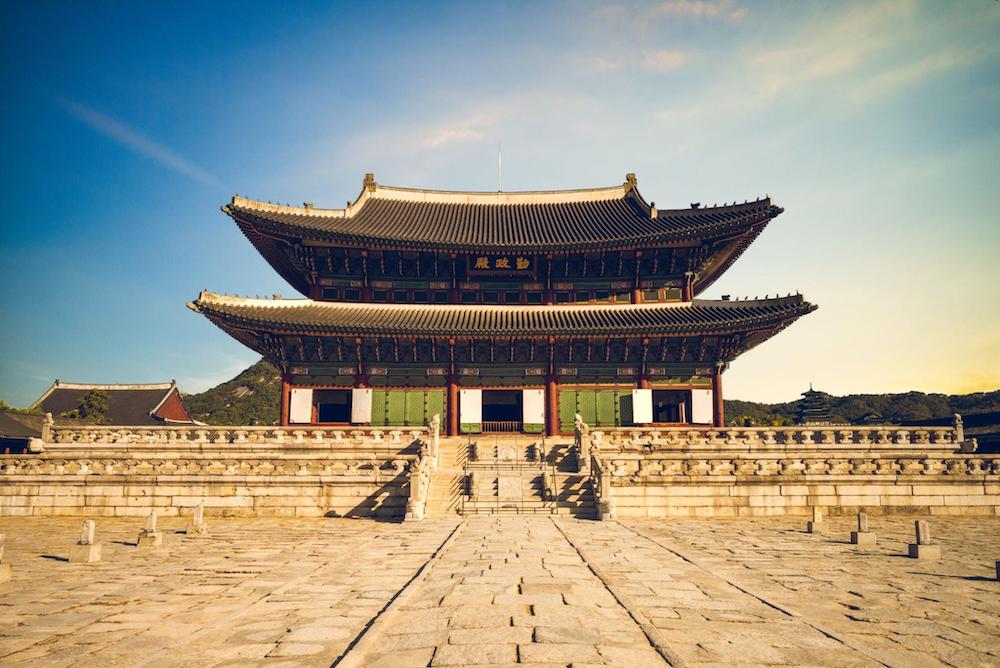
This is the main hall area of the royal palace. You can experience just how vast the grounds of the palace were simply by standing in the middle of the grounds and spinning in a circle, taking in the surroundings.
The center room of the Geunjeongjeon Hall originally served as a venue for state affairs, national ceremonies, and cabinet meetings.
Pose for a picture at HyangwonJeong Pavilion
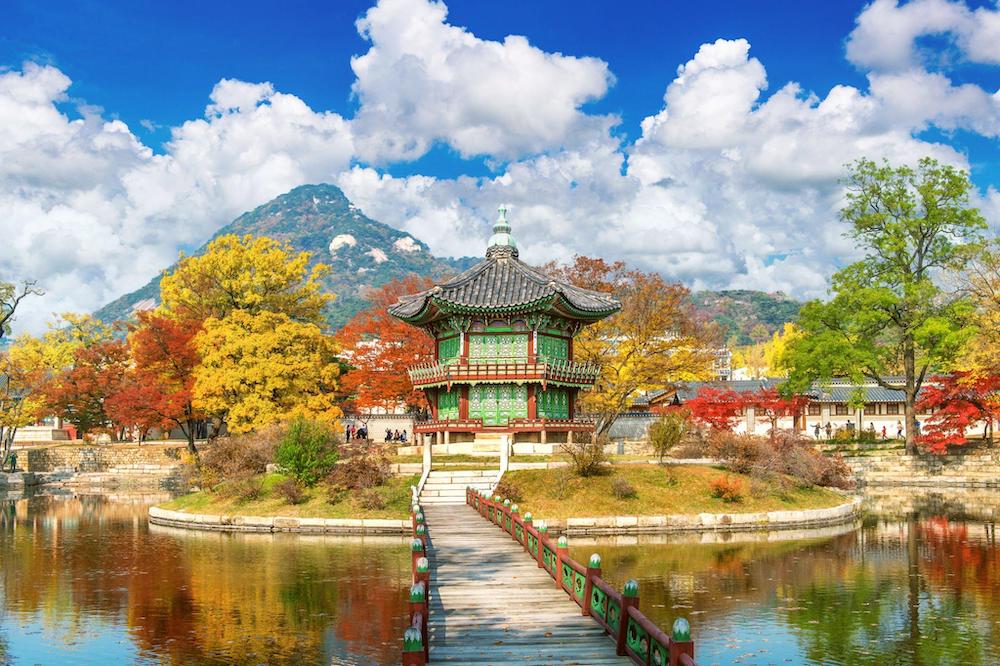
You can’t miss this pavilion, as it’s one of the most beautiful sights of Gyeongbokgung Palace. Many visitors trek to Gyeongbokgung Palace so that they can take photos of the scenic garden and pond surrounding the HyangwonJeong Pavilion.
These are just snapshots of some of the areas you can explore at Gyeongbokgung Palace. To find out about more attractions here, have a look at the official map here.
One thing that we highly, highly recommend is that you rent a hanbok and walk the palace grounds in that. The picture opportunities are simply endless!
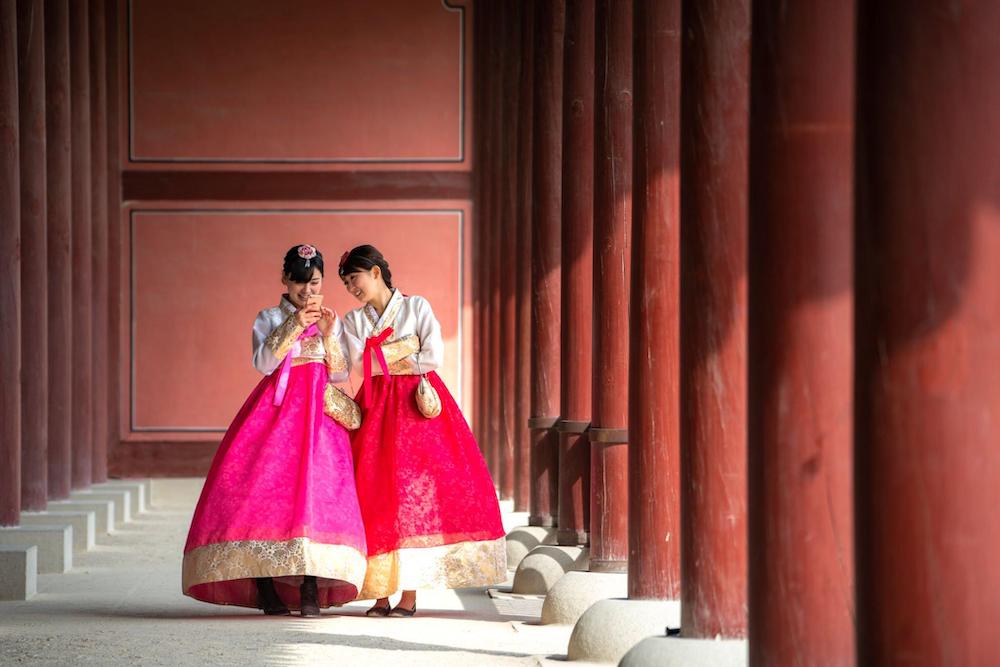
- Address: 161 Sajik-ro, Jongno-gu, Seoul, South Korea
- Hours: Nov-Feb: 9:00am-5:00pm, Mar-May, Sept-Oct: 9:00am-6:00pm, Jun-Aug: 9:00am-6:30pm (Closed Tuesdays)
- Price: Adults – 3,000 won, Children – 1,500 won
10. Visit Baek Inje’s house
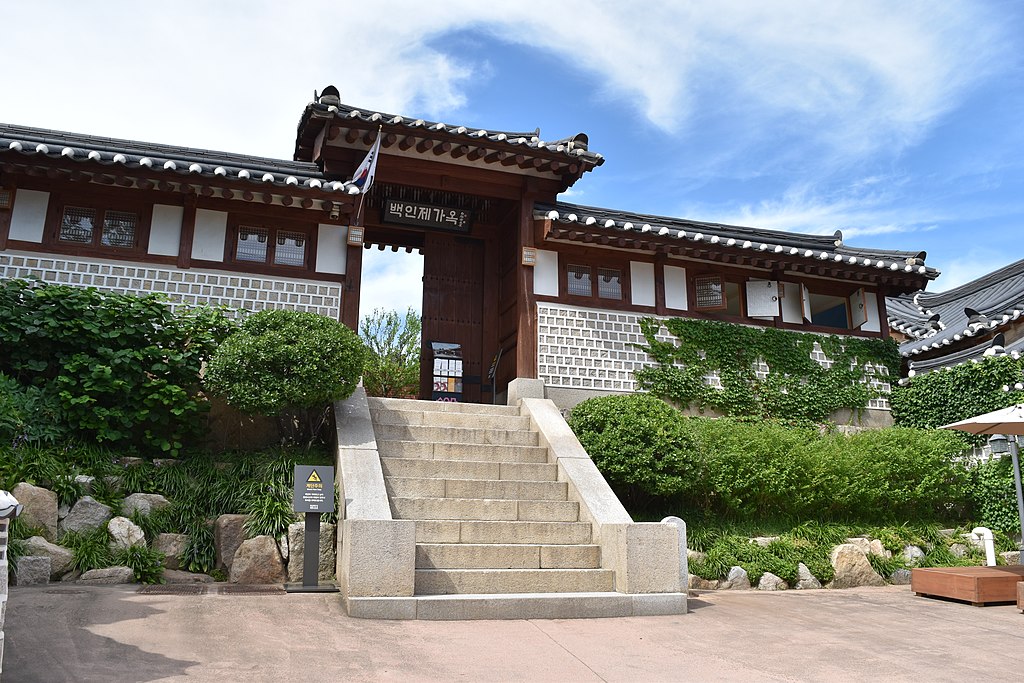
Contrary to its name, Baek Inje’s house exists now as a museum and cultural heritage site that sits within the Bukchon Hanok Village.
Baek Inje was a famous Korean patriot who fought for Korean independence, and who was also a doctor who made some incredible contributions to society.
This hanok home is considered to be one of the first of its kind in what we all know now as a modern hanok. While it still retained many features of a traditional Korean home, the additions of features such as glass windows, red brick, and structural changes set it far apart from what a truly traditional hanok would be.
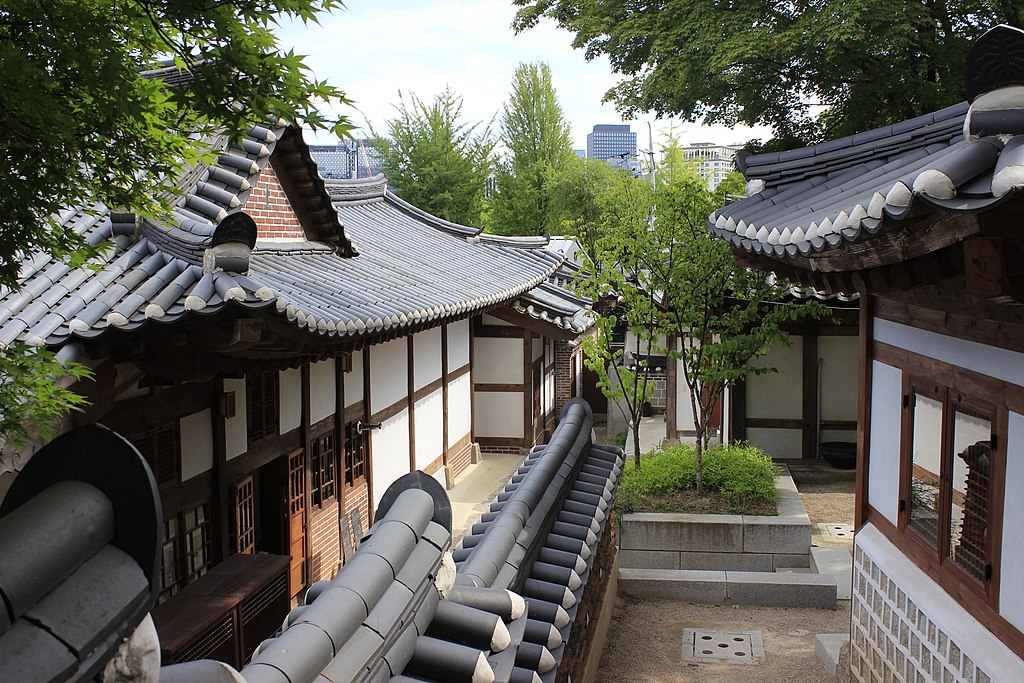
One thing to consider when exploring this site is that it was the first of its kind to connect a sarangchae (men’s quarter) with an anchae (women’s quarters) without the need to exit the house. This was quite a revolution!
This house was superbly built and meticulously maintained. It is a great way to witness how hanoks slowly adapted to modern techniques and trends whilst still maintaining its traditional core.
- Address: 16 Bukchon-ro 7-gil, Jongno-gu, Seoul, South Korea
- Hours: 9:00am-6:00pm (Closed Mondays)
11. Relax at the Cha-teul Traditional Teahouse
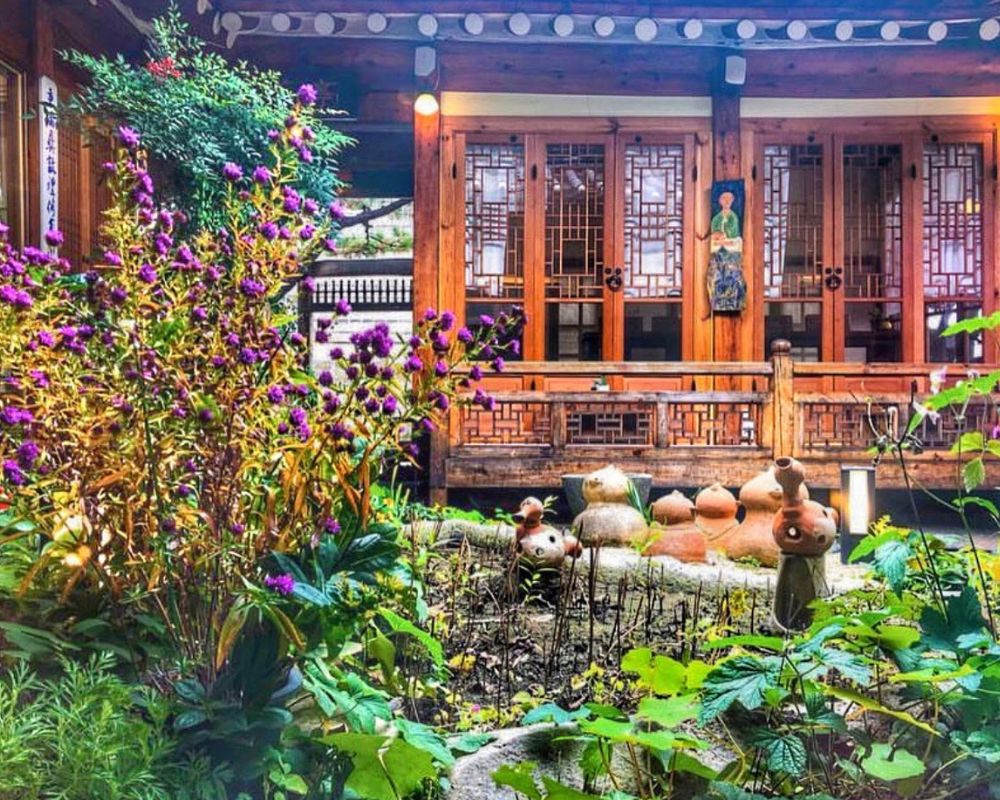
Bukchon Hanok Village is full of fun and cute cafes to check out, one of them being this super cozy and warm teahouse. The Cha-teul Traditional Teahouse is home to more than a hundred years of history with a prime location overlooking the mountains as well as Bukchon Hanok Village.
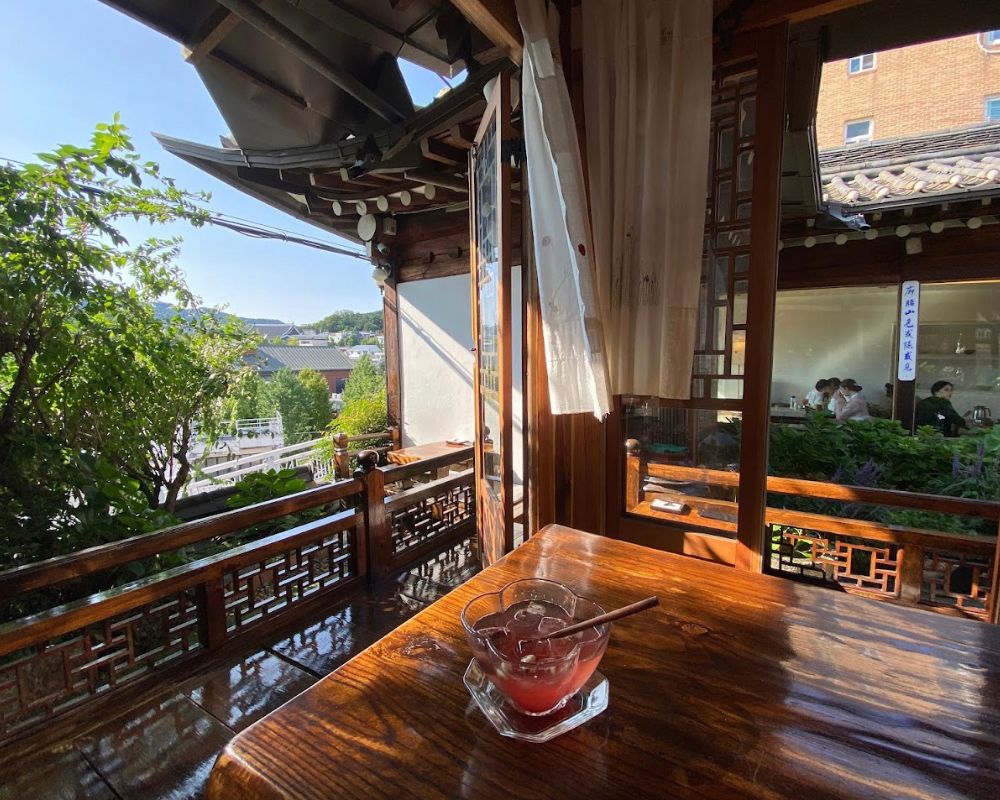
It’s got everything from a stunning courtyard to an abundance of plants, to huge glass windows, traditional wooden furniture, and an immaculate interior set up.
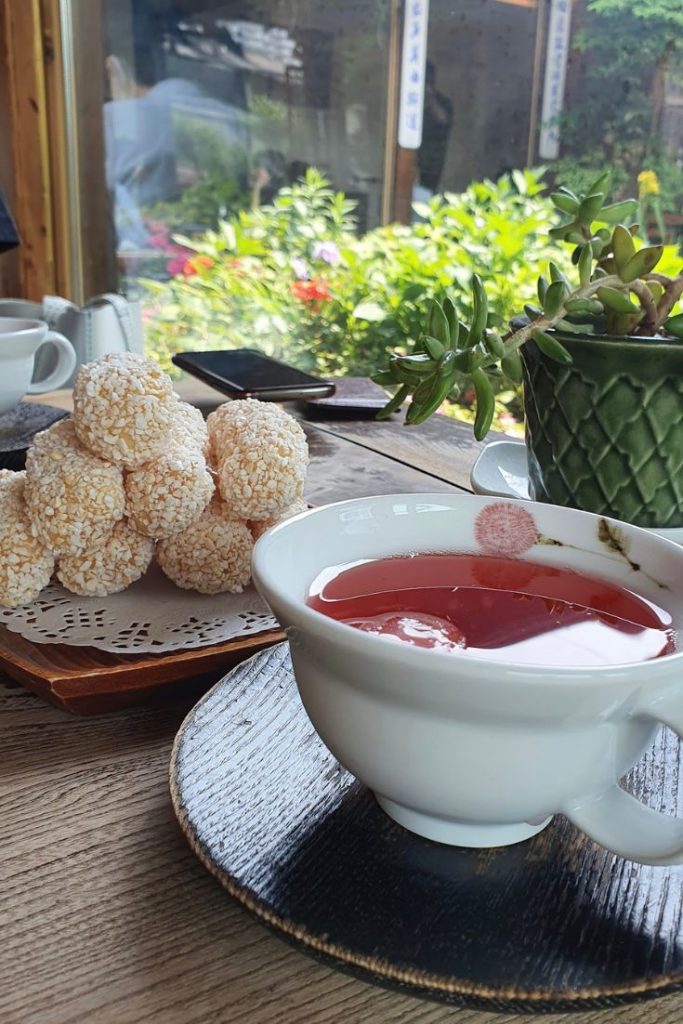
The menu is chock-a-block with traditional Korean snacks such as yugwa (popped rice cakes), and danpatjuk (sweet red bean porridge). They also boast an impressive range of teas and traditional beverages such as red ginseng tangerine peel tea.
- Address: 26 Bukchon-ro 11na-gil, Jongno-gu, Seoul, South Korea
- Hours: Mon-Fri: 12:00pm-9:00pm, Sat-Sun: 11:00am-9:00pm
12. Squeeze in a visit to Ikseondong Hanok Village
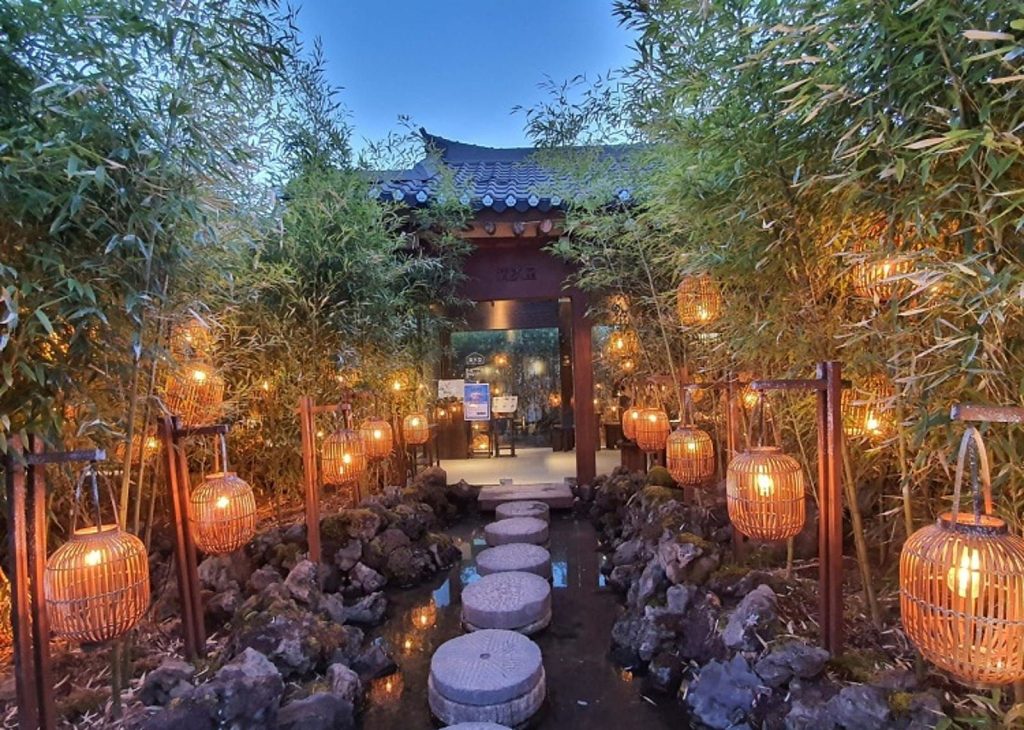
Look, if you’re still looking at ways that you can make the most of your day, why explore another one of Seoul’s stunning hanok villages, located just a short distance away?
Ikseondong is yet another hanok village that boasts years of culture and history, hidden alleyways with well-kept secrets of trendy cafes and restaurants, and plenty of beautiful photo opportunities.
Most of the time, it may not be teeming with as many tourists as Bukchon, so if you’re looking to get away from the crowds, why not consider Ikseondong Hanok Village?
We’ve got a fantastically detailed article written up about how you can best experience Ikseongdong Hanok Village. Have a read of it here: Best Things To Do In Ikseondong Hanok Village.
Where To Stay Near Bukchon Hanok Village
Bonum 1957 Hanok and Boutique
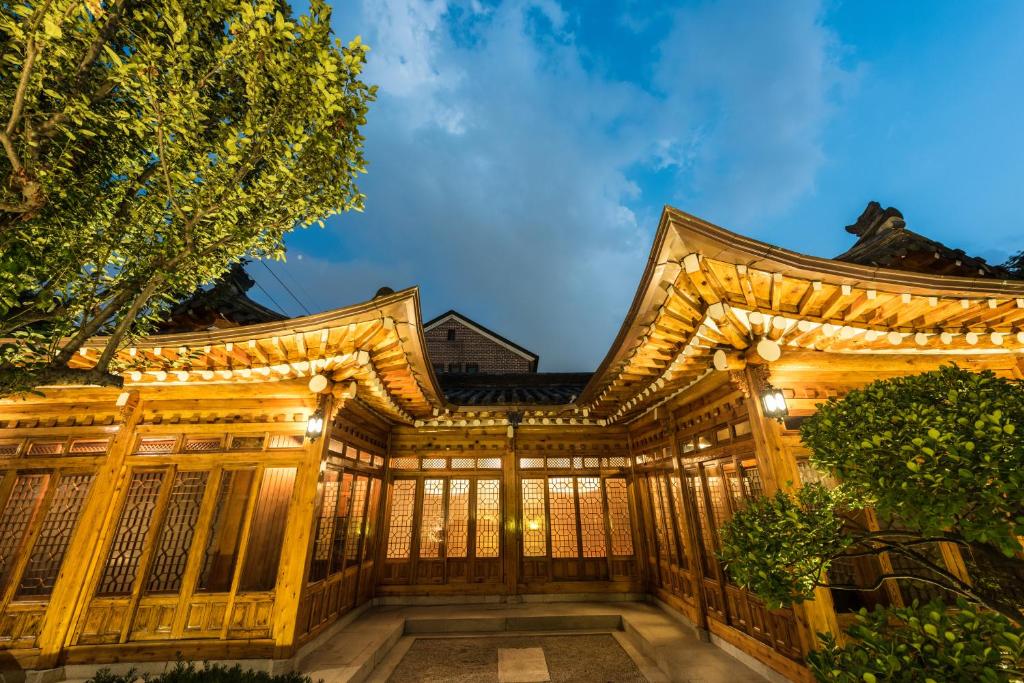
Bonum 1957 Hanok and Boutique offers you the best of both worlds. You can choose between a comfortable and spacious modern-style room with western bedding, lots of natural lighting, and a private bathroom.
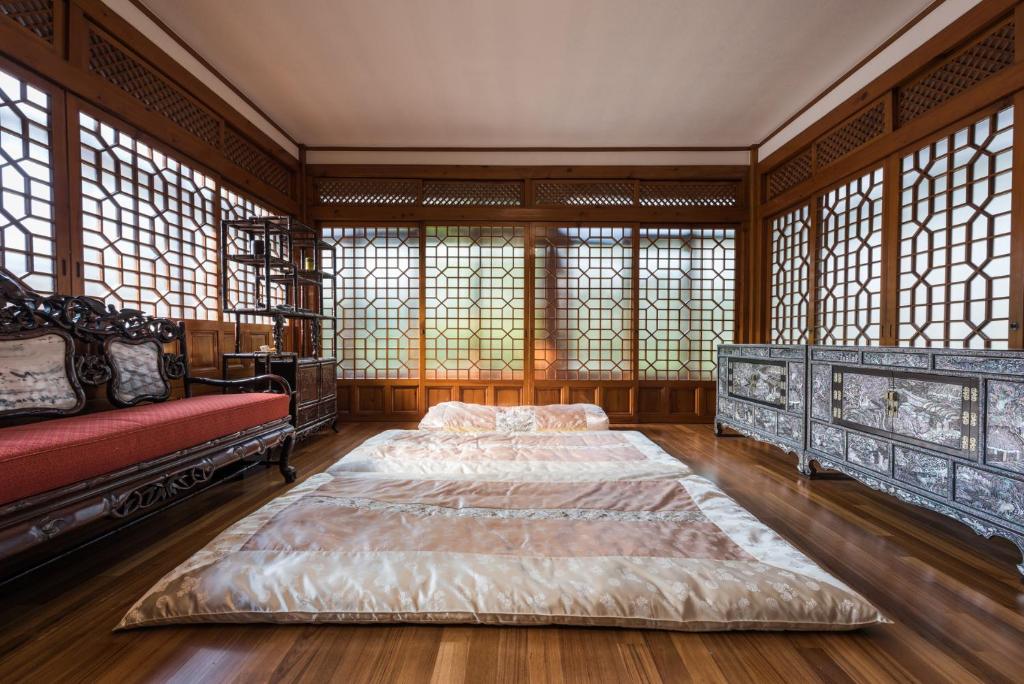
Or, you can select a Korean-style room that’s reminiscent of a hanok, complete with meticulous decor, futon bedding, and traditional furniture. It’s up to you.
Book It Now: Bonum 1957 Hanok and Boutique
For more options, we have listed here 5 more Korean traditional houses: best hanok stay in Seoul.
Nine Tree Premier Hotel Insadong

For a cream-of-the-crop option, the Nine Tree Premier Hotel located in Insadong is absolutely superb. This 4-star hotel is situated conveniently close to Bukchon Hanok Village, and yet its location is also within easy travel distance of plenty of other attractions in Seoul as well.
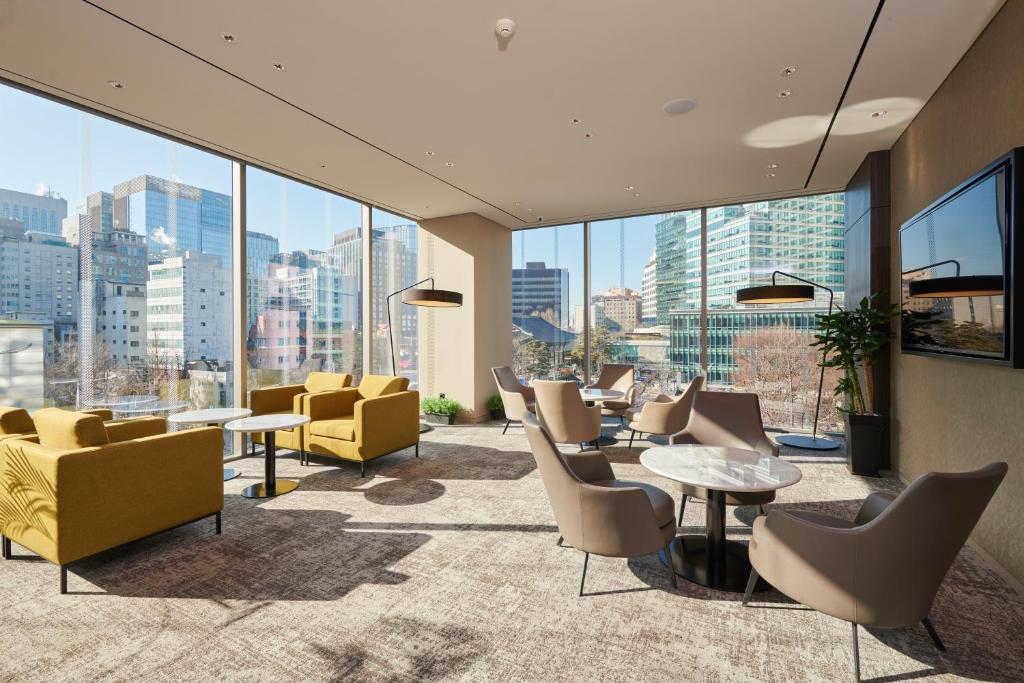
It boasts a business center, a fitness center, a shared modern lounging area, and spacious guest rooms that are, be warned, super inviting (you may not want to leave!), with sweeping views of the city.
Book It Now: Nine Tree Premier Hotel Insadong
Samcheongdong Korea Guesthouse
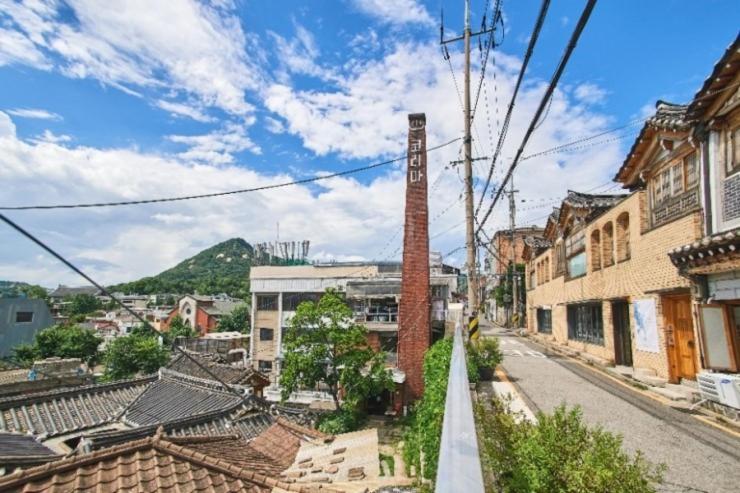
It doesn’t get any more convenient than staying at the Samcheongdong Korea Guesthouse. Located only minutes away from many attractions within the Bukchon Hanok Village, this guesthouse offers spacious rooms, warm and friendly staff members, and all amenities for a comfortable stay.
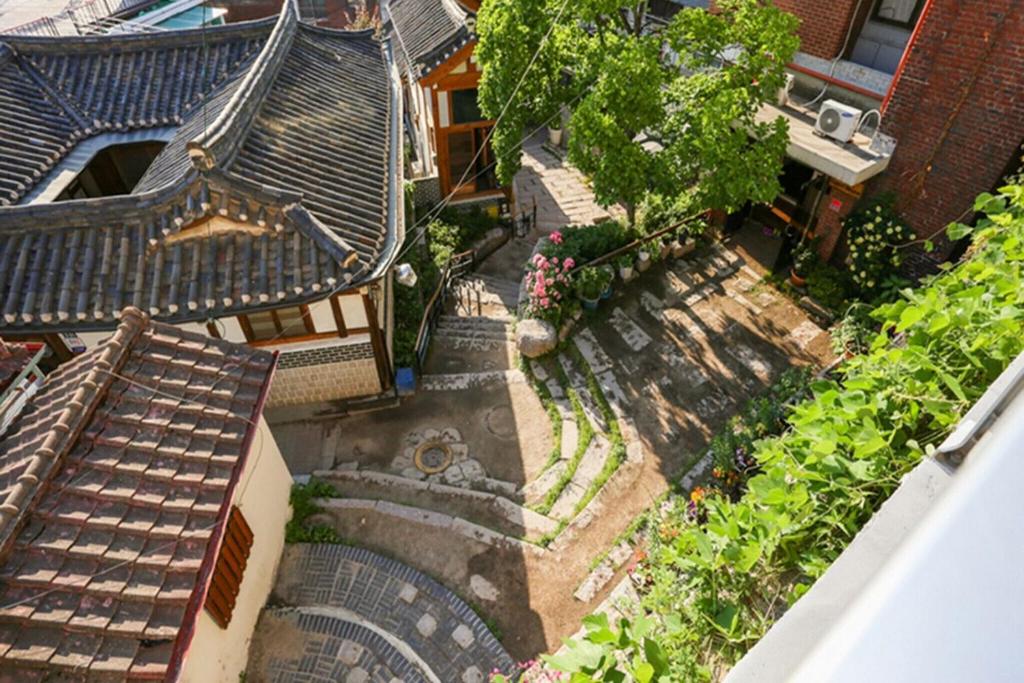
If you’re after affordability and convenience, you can’t look past this guesthouse.
Book It Now: Samcheongdong Korea Guesthouse
How To Get To Bukchon Hanok Village
Bukchon Hanok Village is quite centralized and we’d recommend walking there to truly maximize your experience around Seoul (as most places are walkable in this city).
However, if you’re relying on public transport, simply take the train to Anguk Station (Line 3) and then take exit 3 to the streets. From there, turn right and walk for a few minutes until you see signs pointing you to the village.
Quite honestly, there will likely be other groups heading that direction as well so following the crowd in this instance would not be discouraged either!
—
We hope you enjoyed our guide to the wonderful Bukchon Hanok Village!
As one of the star attractions within Seoul and possibly even South Korea, Bukchon Hanok Village has so much to offer. So much so, that you may even find yourself returning during your second, third, or even your fourth trip back to Korea!
Bukchon Hanok Village is filled to the brim with exciting historical and cultural aspects as well as touches of modernity that make it just so unique and special.
A trip to Seoul simply would not be complete without heading to its most distinguished hanok village.
Have you visited Bukchon Hanok Village before? If so, what was your favorite thing to do there? We’d love to hear all about your experiences in the comments below!
Also, if you’re keen to read more about other hanok villages in Seoul, have a read of our articles about Eunpyeong Hanok Village, Namsangol Hanok Village and Seonchon Hanok Village.
